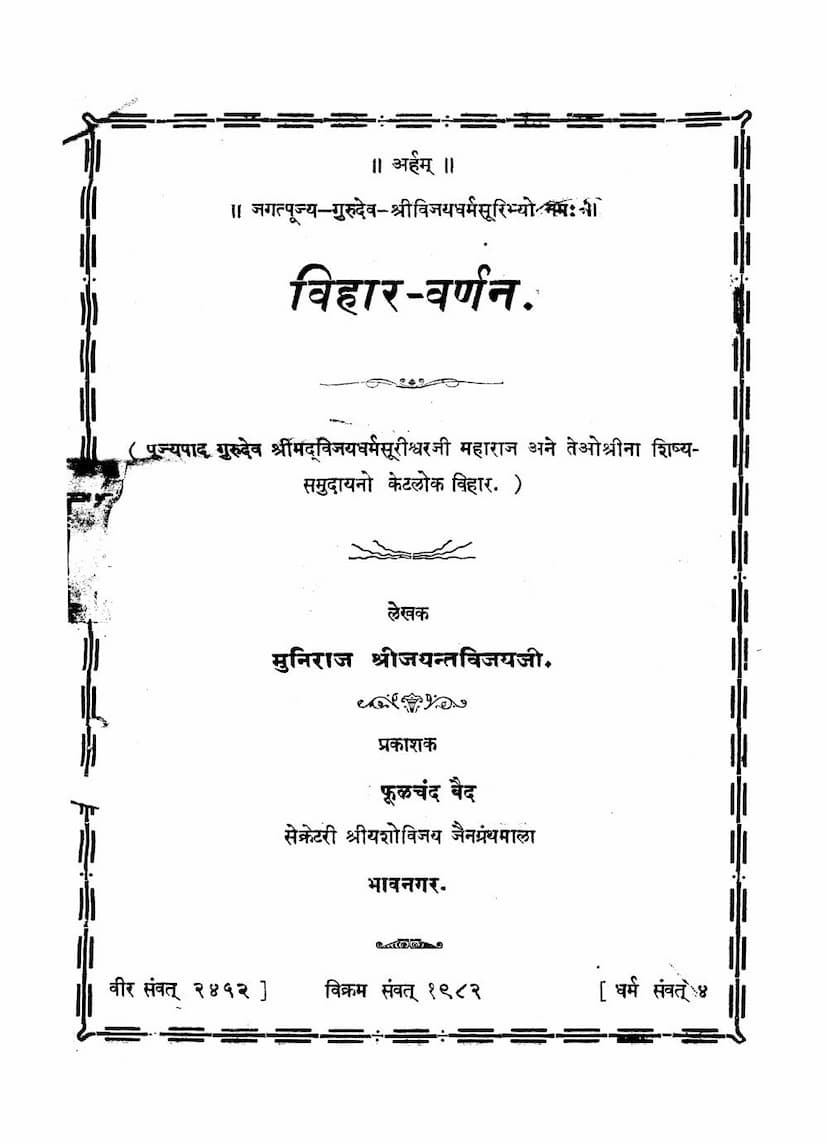Vihar Varnan
Added to library: September 2, 2025

Summary
Here's a comprehensive summary of the Jain text "Vihar Varnan" by Jayantvijay, based on the provided pages:
Book Title: Vihar Varnan (Description of Journeys) Author: Muniraj Shri Jayant Vijayji Publisher: Shri Yashovijay Jain Granthmala, Bhavnagar Publication Year: Vikram Samvat 1982 (1925 AD) / Veer Samvat 2452
Overview:
"Vihar Varnan" is a detailed account of the travels (vihars) undertaken by Pujya Gurudev Shrimad Vijaydharm Surishwarji Maharaj and his disciples. The book meticulously documents the routes, villages visited, duration of stay, and observations made during these journeys. The author, Muniraj Jayant Vijayji, began compiling these notes primarily for personal record-keeping but later felt compelled to expand and publish them for the benefit of the Jain community.
Key Themes and Content:
-
Purpose and Origin:
- The tradition of writing travelogues is ancient, as evidenced by numerous historical manuscripts and pilgrimage accounts.
- Muniraj Jayant Vijayji started recording the vihars of his Guru, Shri Vijaydharm Surishwarji Maharaj, after his own initiation in Samvat 1971.
- Initially, the notes were brief, but as the collection grew, a desire emerged to publish a book about the Guru's travels.
- The author expanded his notes, even creating a questionnaire to gather detailed information from each village.
- He also researched the Guru's earlier travels, resulting in this comprehensive work.
-
Scope of Travels:
- The book covers the vihars of the Guru and his disciples across a vast geographical area, including Gujarat, Kathiawad, Marwar, Mewar, Malwa, Bundelkhand, United Provinces, Magadh, Bengal, Khandesh, Berar, Maharashtra, and Hyderabad (Nizam's territory).
- A total of 1468 villages are described, with 745 having Jain populations, 58 being Jain pilgrimage sites, and 371 villages receiving detailed notes.
-
Utility and Audience:
- The book is considered useful not only for Jain monks (both Shvetambar Murtipujak and others who travel on foot like Sthanakvasi, Terapanthi) but also for history enthusiasts and anyone wishing to compile directories.
- The author suggests that if more monks contributed their travelogues, a comprehensive directory of Jain communities across India could be compiled.
-
Author's Observations and Experiences:
- The author shares significant observations from their extensive travels:
- Impact on Community: The travels of Samvegi Sadhus have influenced the religious practices of people in many villages. In some areas, former Murtipujak Jains have become Sthanakvasi due to a lack of visits from Samvegi Sadhus.
- Influence on Non-Jains: The author believes that Sthanakvasi monks can have an impact on devout Shvetambar Murtipujak villagers but struggle to influence other sects, including Digambar Jains, in regions like Bundelkhand and the United Provinces, despite significant Digambar populations.
- Conversion Potential: The author notes that in areas like Agra, many Pallival Jains, originally Shvetambar, have adopted Sthanakvasi or Digambar practices due to the absence of Samvegi monks. Regular visits by monks could be highly beneficial.
- Challenges in Specific Regions: The author highlights difficulties faced by Samvegi Sadhus in regions with strong Terapanthi influence (like Marwar and Mewar), as their followers can be more dogmatic and less accommodating.
- Need for Qualified Monks: For distant regions like Bengal, Magadh, Sindh, Maharashtra, and Madras, the author emphasizes the need for monks who are learned, wise about time and place, capable of public speaking, tolerant of other religions, and able to endure physical hardships. He discourages general monks from traveling to these distant areas purely for sightseeing or pilgrimage, as it can lead to deviations from strict practices and misguidance of the local populace. Instead, such monks are better suited to serve their home regions.
- The author shares significant observations from their extensive travels:
-
Structure of the Book:
- The book is divided into four sections:
- Section 1: A list of vihars based on the author's personal experiences.
- Section 2: A list of vihars compiled from the books of other monks.
- Section 3: Notes related to the villages mentioned in the first two sections.
- Section 4: A list of Jain pilgrimage sites, distances of major towns, and information about paved roads mentioned in the book.
- The book is divided into four sections:
-
Appendices and Supplementary Information:
- Symbolic Description (सांकेतिक वर्णन): Explains symbols used for various aspects of the journey, such as arrival customs (○, ○○, ○○○), public lectures (-), absence from a village (*), and alternate routes (इ).
- Glossary (संकेतिक चिहोनी ओलखाण): Defines abbreviations used for names of places, communities, and titles.
- Explanations (समजुती): Clarifies how mileage, house counts, temple counts, and Upashray counts are recorded.
- Acknowledgements (उपकार): The author expresses gratitude to numerous individuals who assisted in compiling and publishing the book, including Shri Vijyendrasuri Maharaj, Upadhyay Shri Mangalvijayji Maharaj, and Muniraj Shri Vidyavijayji Maharaj.
- Errata (शुद्धिपत्रक): A request for readers to report any errors found in the text for correction in future editions.
Overall Significance:
"Vihar Varnan" is a valuable historical and geographical document within Jain literature. It provides an invaluable glimpse into the extensive missionary activities of Jain monks in the early 20th century, detailing the socio-religious landscape of numerous regions and offering insights into the challenges and successes of spreading Jain teachings. The meticulous record-keeping makes it a significant resource for researchers of Jain history, geography, and sociology.